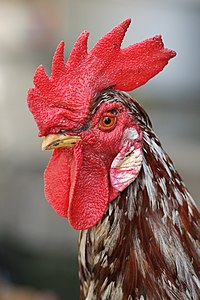
Photo from wikipedia
Parasitic infections in pigeons are very important due to their adaptability to different environmental conditions, as well as their relationship with human society. In this study, 250 samples of domestic… Click to show full abstract
Parasitic infections in pigeons are very important due to their adaptability to different environmental conditions, as well as their relationship with human society. In this study, 250 samples of domestic and wild pigeons (Columba livia) were collected from different areas in Samawah, Al-Muthanna province, Iraq, from March 2020 to January 2021. Clinical examination of external parasites was conducted by screening fecal samples for intestinal parasitic infections and preparing direct swabs from the beaks. Out of the 250 pigeon samples (125 domestic and 125 wild pigeons), 65 pigeons were found infected (26%), including 40 domestic (32%) and 25 wild pigeons (20%) (P≤0.05). The results showed that these parasitic infections belong to three major groups of bird parasites: 1) Protozoa, such as Eimeria species (spp.) oocyst, Cryptosporidium spp., and Trichomonas gallinae, with prevalence rates of 21 (16.8%), 14 (11.2%), 19 (15.2%), 11(8.8%), 7 (5.6%), and 2 (1.6%), 2) Helminths, such as cestodes (Raillietina tetragona) and nematodes (Ascaridia columbae) with prevalence rates of 5 (4%), 4 (3.2%), 4 (3.2%), and 2 (1.6%), as well as Arthropods, including lice (Menacanthus stramineus) with prevalence rates of 5 (4%) and 3 (2.4%) in domestic and wild pigeons, respectively. Additionally, no significant difference was found between male and female pigeons in their infection rate (P≤0.05). The findings also revealed that the highest percentage of infection in both genders of domestic and wild pigeons was caused by one spp. of parasites (62.5% and 64% in domestic and wild pigeons, respectively), followed by two spp. (24% and 27.5% in domestic and wild pigeons, respectively), and three spp. of parasites (10% and 12% in domestic and wild pigeons, respectively). However, there was no significant difference between domestic and wild pigeons regarding their infections with one, two, or three spp. of parasites (P≤0.05). It is thus concluded that differences in the prevalence of these parasites in different regions are partly due to differences in nutrition, feeding habits, and geographical environment.
Journal Title: Archives of Razi Institute
Year Published: 2022
Link to full text (if available)
Share on Social Media: Sign Up to like & get
recommendations!